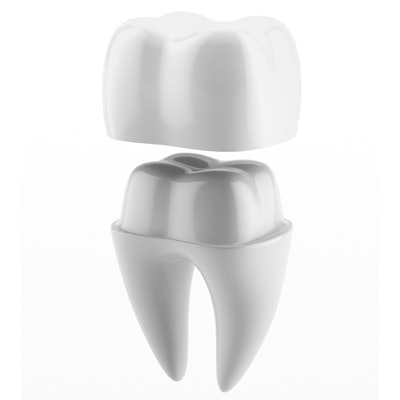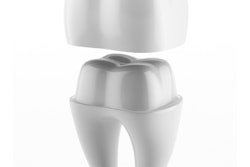
If you use ceramic materials to fabricate single-molar CAD/CAM crowns, how do you determine which will hold up best? Researchers put six silicate ceramic materials through testing at three thicknesses to find out which could handle the highest fractural loading. The results might change which material you use.
The researchers found that the greater the thickness, the higher the survival rate. While all crowns survived fatigue testing at a thickness of 1.5 mm, only one survived close to 40% of the time at a thickness of 0.5 mm.
"For material thicknesses of 0.5, 1.0, and 1.5 mm, there are statistically significant differences for the maximum fractural load depending on the respective CAD/CAM material," the study authors wrote (Dental Materials Journal, August 24, 2017).
The study was led by Moritz Zimmermann, DDS, of the department of computerized restorative dentistry at the Center of Dental Medicine at the University of Zurich in Switzerland.
Fractural load
Ceramic materials are often used in the fabrication of CAD/CAM restorations, but they admittedly are more likely to fracture than composite resin materials. The researchers wanted to find out if the maximum fractural load of newer CAD/CAM ceramic materials depended on the material thickness of the restoration. They initially thought they would find differences in results across the different materials tested.
The study tested six silicate ceramic materials:
- Mark II (Vita) -- a feldspar ceramic
- IPS e.max CAD (Ivoclar Vivedent) -- a lithium disilicate ceramic
- Celtra Duo after milling (Dentsply Sirona) -- a zirconia-reinforced lithium silicate (ZLS) ceramic
- Celtra Duo after firing (Dentsply Sirona) -- a ZLS ceramic
- Suprinity (Vita) -- a ZLS ceramic
- Enamic (Vita) -- a hybrid ceramic
For the six different materials, eight crowns each were fabricated with thicknesses of 0.5 mm, 1.0 mm, and 1.5 mm for a total of 144 crowns.
The researchers first used a chewing simulator to exert fatigue on these materials (fatigue testing). If they saw cracks via stereomicroscope viewing after this testing, they eliminated the crown from further testing.
For the thinnest group with a material thickness of 0.5 mm, only five CAD/CAM crowns survived to move on to the next stage of testing:
- IPS e.max CAD -- one crown survived
- Celtra Duo -- one crown survived
- Vita Suprinity -- three crowns survived
Fatigue-testing results were more promising in the 1.0-mm thickness group, in which more than 30 crowns survived fatigue testing:
- Mark II -- seven crowns survived
- IPS e.max CAD -- eight crowns survived
- Celtra Duo after milling -- one crown survived
- Celtra Duo after firing -- eight crowns survived
- Suprinity -- six crowns survived
- Enamic -- eight crowns survived
All crowns in the 1.5-mm thickness group survived fatigue testing.
The crowns that survived fatigue loading advanced to fracture loading testing, which enables researchers to discover the force (in Newtons) at which the materials failed. The researchers used a universal testing machine to determine the materials' strength for this part of the study.
The maximum fractural load significantly varied among the groups, the authors reported. The weakest and strongest silicate crown materials as determined by the fracture loading tests are shown in the tables below. For the 0.5-mm group, only the Suprinity material had more than one crown that survived fatigue testing.
| Weakest silicate crown materials by thickness | ||
| Thickness | Material | Maximum fractural load at failure (in Newtons) |
| 1.0 mm | Mark II | 482.0 N |
| 1.5 mm | Mark II | 634.8 N |
| Strongest silicate ceramic crown materials by thickness | ||
| Thickness | Material | Maximum fractural load at failure (in Newtons) |
| 0.5 mm | Suprinity | 660.1 N |
| 1.0 mm | IPS e.max CAD | 774.2 N |
| 1.5 mm | IPS e.max CAD | 1,240.8 N |
One thickness recommended
The authors listed three potential study limitations: Only one parameter, minimum material thickness, was evaluated; new testing methods may provide more data in future studies; and each test group had a small sample size.
However, they concluded that only one of the three thicknesses was clinically recommended.
"Assuming a maximum chewing force of 600-800 N, all silicate ceramic CAD/CAM materials with a thickness of 1.5 mm may be appropriate for clinical use," the authors wrote.



















